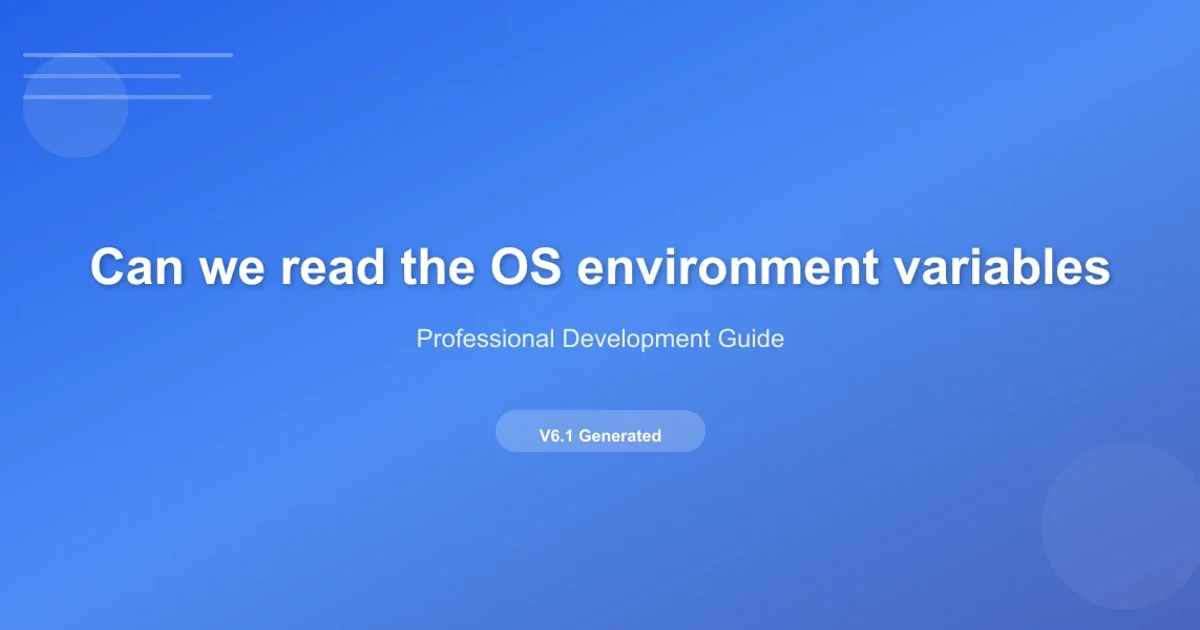Can we read the OS environment variables in Java?
Categories:
Accessing OS Environment Variables in Java

Learn how to read and manage operating system environment variables within your Java applications, covering various methods and best practices.
Environment variables are dynamic named values that can affect the way running processes will behave on a computer. They are part of the operating system's environment and can be used to store configuration settings, paths to executables, or other system-wide information. Java applications often need to access these variables for various reasons, such as database connection strings, API keys, or system-specific configurations. This article will guide you through the different ways to read OS environment variables in Java.
Understanding Environment Variables
Before diving into the Java code, it's crucial to understand what environment variables are and why they are used. They provide a way to configure applications without modifying their code, making them more flexible and portable across different environments (development, testing, production). For example, a database URL might differ between a local development setup and a production server. Instead of hardcoding it, you can store it in an environment variable, and your Java application can read it at runtime.
flowchart TD
OS[Operating System] --> EnvVars(Environment Variables)
EnvVars --> JavaApp[Java Application]
JavaApp --> Config(Configuration Settings)
Config --> Behavior(Application Behavior)
subgraph External Configuration
DB_URL[Database URL]
API_KEY[API Key]
PATH[System Path]
end
EnvVars --- DB_URL
EnvVars --- API_KEY
EnvVars --- PATH
JavaApp -.-> DB_URL
JavaApp -.-> API_KEYHow Java Applications Interact with OS Environment Variables
Reading a Single Environment Variable
The most common way to read a specific environment variable in Java is by using the System.getenv(String name) method. This method returns the string value of the specified environment variable, or null if the variable is not defined in the system's environment. It's important to handle the null case to prevent NullPointerExceptions.
public class EnvironmentVariableReader {
public static void main(String[] args) {
// Read a specific environment variable
String path = System.getenv("PATH");
if (path != null) {
System.out.println("PATH environment variable: " + path);
} else {
System.out.println("PATH environment variable not found.");
}
String myCustomVar = System.getenv("MY_CUSTOM_VAR");
if (myCustomVar != null) {
System.out.println("MY_CUSTOM_VAR: " + myCustomVar);
} else {
System.out.println("MY_CUSTOM_VAR not set. Please set it before running.");
}
}
}
Example of reading a single environment variable using System.getenv().
Accessing All Environment Variables
If you need to inspect all environment variables available to the Java process, you can use the System.getenv() method without any arguments. This method returns an unmodifiable Map<String, String> that represents the current system environment. The keys in the map are the variable names, and the values are their corresponding string values.
import java.util.Map;
public class AllEnvironmentVariables {
public static void main(String[] args) {
Map<String, String> env = System.getenv();
System.out.println("\n--- All Environment Variables ---");
for (Map.Entry<String, String> entry : env.entrySet()) {
System.out.println(entry.getKey() + " = " + entry.getValue());
}
System.out.println("-----------------------------------");
}
}
Iterating through all available environment variables.
Setting Environment Variables
While Java can read environment variables, it cannot directly set or modify them for the parent process or other processes. Environment variables are typically set at the operating system level or by the shell/script that launches the Java application. However, you can set environment variables for child processes that your Java application might spawn using ProcessBuilder.
import java.io.IOException;
import java.util.Map;
public class ProcessBuilderEnv {
public static void main(String[] args) throws IOException, InterruptedException {
ProcessBuilder pb = new ProcessBuilder("bash", "-c", "echo $MY_CHILD_VAR");
Map<String, String> env = pb.environment();
env.put("MY_CHILD_VAR", "Hello from Java!");
env.remove("PATH"); // Example: remove an inherited variable
Process p = pb.start();
int exitCode = p.waitFor();
System.out.println("Child process output:");
new java.io.BufferedReader(new java.io.InputStreamReader(p.getInputStream()))
.lines().forEach(System.out::println);
System.out.println("Child process exited with code: " + exitCode);
}
}
Setting environment variables for a child process using ProcessBuilder.